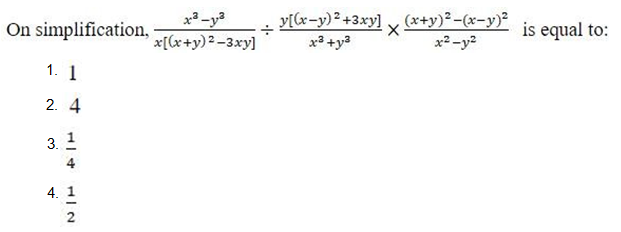Question
Quantity-I: 'Asmita' is able to finish 32% of a task in
16 days. 'Ben' can complete the same task in 10 days fewer than 'Asmita'. Calculate the time it would take for both 'Asmita' and 'Ben' to complete 90% of the task together. Quantity-II: 18 days In the given problem, two quantities, I and II, are presented. You are required to solve both quantities and determine the correct relationship between them.Solution
ATQ, Quantity I: Time taken by ‘Asmita’ to complete the whole task = 16/0.32 = 50 days Time taken by ‘Ben’ to complete the whole task = 50 – 10 = 40 days Let the total task be = 200 units Efficiency of ‘Asmita’ = 200/50 = 4 units/day Efficiency of ‘Ben’ = 200/40 = 5 units/day Required time taken = 0.9 × 200/9 = 20 days Quantity II: 18 days
If p = 24 - q - r and pq + r(q + p) = 132, then find the value of (p² + q² + r²).
((99.9 - 20.9)² + (99.9 + 20.9)² )/(99.9 x 99.9 + 20.9 x 20.9) = ?
...
Find the value of the given expression-
(4x+4 -5× 4x+2) / 15×4x – 22×4x
If 4x² + y² = 40 and x y = 6, then find the value
of 2x + y?
If p = 40 - q - r and pq + r(q + p) = 432, then find the value of (p² + q² + r²).
47.98 × 4.16 + √325 × 12.91 + ? = 79.93 × 5.91
If x + y = 4 and (1/x) + (1/y) = 24/7, then the value of (x3 + y3).
- If p = 20 - q - r and pq + r(p + q) = 154, then find the value of (p² + q² + r²).
If a = (√2 - 1)1/3, then the value of (a-1/a)3 +3(a-1/a) is:


